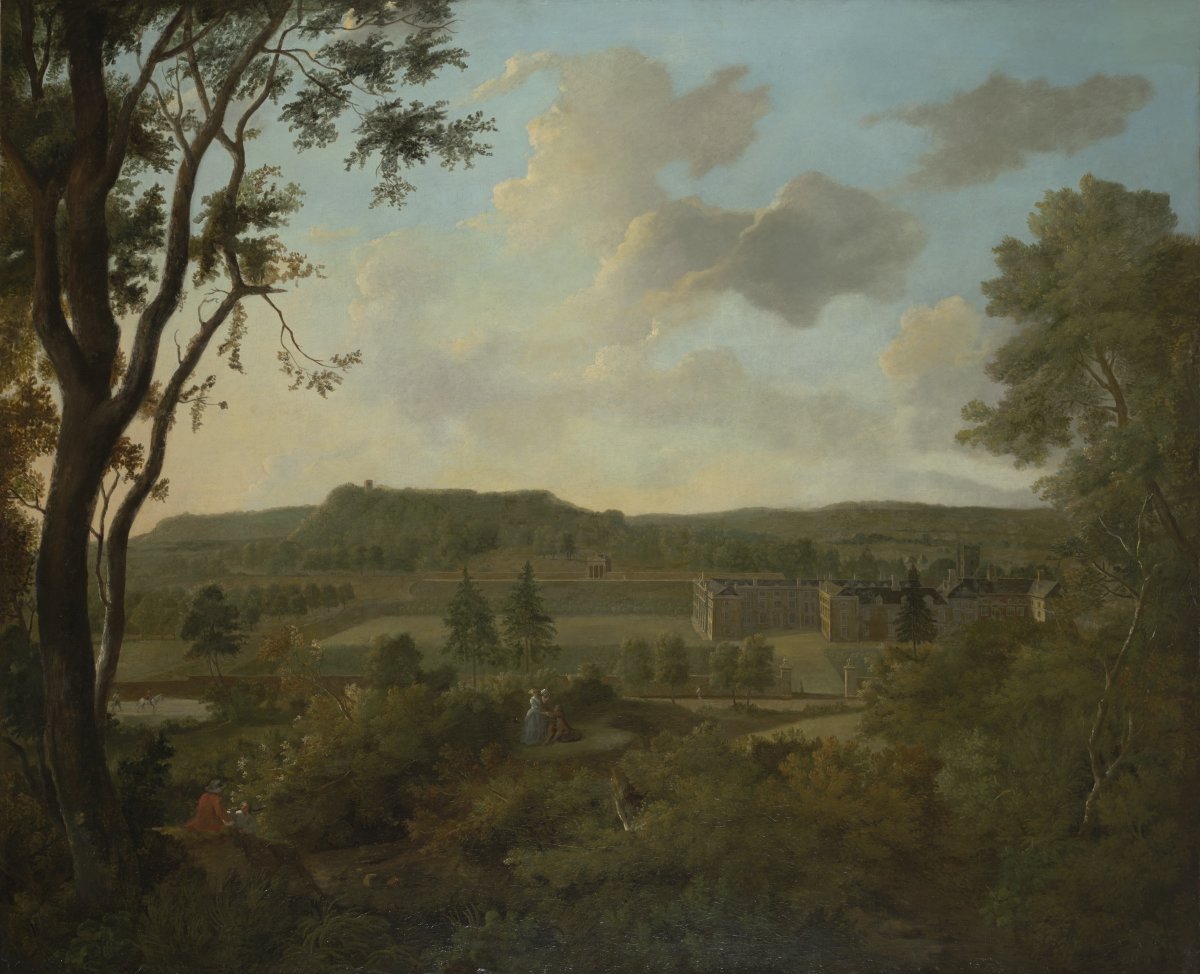Fonthill Redivivus, Wiltshire

-
About the work
- Location
-
Country: UK
City: London
Place: Government Hospitality, Lancaster House
This view of the Fonthill estate in Wiltshire includes the second house at Fonthill, known as Fonthill 'Redivivus'. The original house was a 16th-century building, belonging to the Mervyn family. The estate later passed to the Cottingham family, who are said to have asked Inigo Jones to replace the 16th-century residence with this new house in the Italianate style of the 1630s. Alderman William Beckford, a plantation owner, bought the estate from Francis Cottington in about 1736 and commissioned George Lambert to paint this view of the property in 1740. Except for the two piers, which have already replaced the Tudor gateway, the landscape is shown just before Beckford began to make alterations to the estate. The medieval parish church, visible in the painting just behind the house and to the right, was later taken down by Beckford, who thought it ‘too near and unseemly’. The lake and bridge added by Beckford have yet to be constructed. After seeing the house in 1754, Bishop Pococke described it as ‘fronted in the Italian taste’. The following year it would be burnt to the ground. However, a new house was built on the site by Beckford and named Fonthill 'Splendens'.
It has been suggested that the figures in this painting were added by painter and engraver William Hogatrth (1697-1764).
-
About the artist
George Lambert, theatre scene and landscape painter, divided his career equally between the two professions. For most of his life he lived in Covent Garden. His early style of the 1720s is similar to that of John Wootton. However, his later classical landscapes earned him the accolade ‘the English Poussin’. Lambert painted the landscape backgrounds for William Hogarth’s paintings ‘The Pool of Bethesda’ and ‘The Good Samaritan’, made for St. Bartholomew’s Hospital (1736-37). In 1761 he was elected chairman of the newly founded Society of Artists of Great Britain. The Society received the Royal Seal on 26th January 1765 and just five days later Lambert died at his home in Covent Garden, leaving his possessions to his servant, Ann Terry.
-
Explore
- Places
- England, Fonthill House, Wiltshire
- Subjects
- horseback, topography, landscape C18th, genre, tree, horse, hill, man, woman, child, gate, garden, lawn, country house/mansion, house, wall
- Materials & Techniques
- canvas, oil, oil painting
-
Details
- Title
- Fonthill Redivivus, Wiltshire
- Date
- 1740
- Medium
- Oil on canvas
- Dimensions
- height: 162.50 cm, width: 198.50 cm
- Acquisition
- Purchased from Gooden & Fox, July 1965
- Inscription
- lr: G. Lambert 1740
- Provenance
- Probably commissioned by William Beckford (c.1709-1770), who purchased the Fonthill estate in c.1744; collection of William Thomas Beckford (1760-1844), Fonthill, Wiltshire, by 1801 (recorded as ‘A large and fine landscape by Lambert representing Fonthill as it appeared in 1740, the figures by Hogarth’); probably sold through Harry Phillips (auctioneer), London, on 9 July 1825 (Lot 26), as Lambert ‘View of Fonthill’; collection of Irish peer Mervyn Wingfield, 7th Viscount Powerscourt (1836-1904) of Powerscourt, Enniskeryy, County Wicklow, Ireland; by whom sold through Christie’s, London, on 5 March 1900 (Lot 94), as ‘Fonthill, Wilts.’ by R. Wilson, for £1.16.0; from which sale purchased by ‘Parsons’; with S. J. Smith & Son of 42 Duke Street, St James's, London; by whom sold through Christie’s, London, on 12 December 1903 (Lot 85), for £9.9.0; from which sale purchased by 'Johnson', probably Oscar Johnson (dealer); collection of ‘A. Lassen’; from whom purchased by Gooden & Fox, London, in February 1965; from whom purchased by the Ministry of Works in July 1965
- GAC number
- 7074